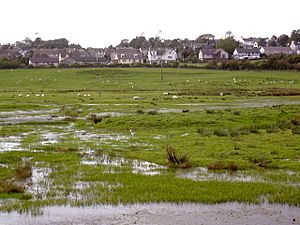Wigtown Bay facts for kids
Wigtown Bay is a large inlet of the Irish Sea found on the coast of southwest Scotland. It's a beautiful part of the region known as Galloway. The entire coastline of the bay is within the area of Dumfries and Galloway. It also touches parts of the historic counties of Wigtownshire and Kirkcudbrightshire.
The bay has a shape like a triangle, getting wider towards the southeast. The River Cree flows into the bay from the northwest. The inner parts of Wigtown Bay have large areas of salt marsh and mudflats. These are special habitats for many plants and animals. The River Bladnoch also joins the River Cree near the town of Wigtown. Another important river, the Water of Fleet, flows into Wigtown Bay through Fleet Bay. Near the mouth of Fleet Bay, you can find the Islands of Fleet. These include Ardwall Island, Barlocco Isle, and Murray’s Isles. The western side of the bay is formed by a peninsula called The Machars. Along this coast, there are smaller bays like Rigg Bay and Garlieston Bay, where the village of Garlieston is located. The small town of Wigtown is also on the western shore. The village of Creetown sits at the very top of the bay.
Britain's Largest Nature Reserve
Wigtown Bay is very special because it is the largest local nature reserve in Britain. This means it's a protected area where nature can thrive. It has also been named a site of special scientific interest. This is another important way to protect its unique wildlife and habitats.
Plans for Wind Turbines
Sometimes, there are ideas to build things in natural areas. In 2011, there was a plan to build an offshore wind farm in Wigtown Bay. A wind farm uses large turbines to create electricity from the wind. However, the Scottish government decided not to allow this project. One big reason was the worry that it might affect tourism in the area. People love to visit Wigtown Bay for its natural beauty.
Later, around 2014, another company called Ecotricity proposed building more wind turbines. This time, the turbines would be on land overlooking the bay. Many people and local groups were against this plan. They were concerned about how the large turbines would look and affect the environment. Over 1,000 people sent objections to the plan. Several local community councils also opposed it.
Despite the objections, the company continued with their plans. They even appealed directly to the Scottish Government when local councils turned down their initial requests. However, in July 2016, the Scottish Government dismissed Ecotricity's appeal. This meant the plan for the industrial turbine site was rejected.
Wigtown Bay has an interesting link to history, especially to World War II. The design for the floating Mulberry Harbour was tested here. These special harbours were used by Allied forces during the successful invasion of Normandy. The conditions in Wigtown Bay were similar to those off the coast of Normandy, making it a good testing ground. There was also a Bay class frigate named HMS Wigtown Bay. This was a type of warship used during the Second World War.


